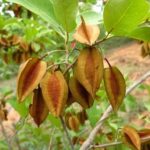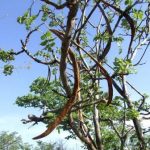TREE LIFE
OCTOBER 1981
MASHONALAND CALENDAR
Tuesday October 6th : Botanic Garden Walk. Meet in the Car Park at 1646 hours for 1700 hours.
Sunday October 18th : Wicklewood Farm, Marondera, home of Tim and Poppy Casewell.
When Paul and I visited Wicklewood recently many of the trees were still bare and we were unable to find Jatropha curcas, physic nut, which we had seen previously, but we did find a Ficus capensis, Cape Fig, with a buttressed trunk and Cussonia natalensis, simple leaved Cussonia in flower, as were Diospyros whyteana, bladder nut and Crassocephalum mannii, canary creeper tree. This is another farm were the trees have been preserved and we have chosen Marandellas for the October meeting in the hope that it might not be too hot.
BOTANIC GARDEN WALK 1ST SEPTEMBER
This visit was most stimulating both physically and mentally. It looked as though a storm was brewing and were braced by the stiff breeze off the rain which did not arrive. However, just to add to the realism, Tom Muller rushed us through various irrigation sprays as we looked at some of the forest, dry forest, and out-lier forest trees which we hope to see on our trip to Umtali and which I will tell you about in the next Newsletter.
BINGA SWAMP FOREST
Despite the freezing conditions of the preceding week, there was a good turn out of members and visitors – 34 in all – at Binga Swamp Forest on Sunday, 6th September. The weather smiled on us for venturing out, and never had the early morning and late afternoon sun shown off to better advantage the glistening reds and coppers of the msasas on the surrounding hills. (The glory of the early morning display is hearsay. It was vouched for by Bird Society members who tend to rise with the lark, or the toppie, either to relieve the stress of insomnia or – as they claim – to enjoy the relative quiet that prevails before the arrival of their Tree Society associates at a more civilized hour. Notwithstanding their slanderous accusation that profound discussion on dicotyledons and interpetiolar stipules would disturb the tranquillity of the sylvan glades at dawn, we always seem to enjoy our outings more when they are with us, and on this occasion, they identified no less than 65 bird species within the confines of the forest and its immediate surrounds.
We spent a pleasant morning in the forest, beginning with a review of the 10 year fight to conserve it, since the desirability of its conservation was first brought to the attention of the Natural Resources Board (NRB) by the then President of the Society, Mr. Chris Lightfoot.
In the intervening years the NRB, the Arcturus Rural Council, the Henderson Weed Research Unit and the Tree Society have all played a part; the most effective single contribution towards the elimination and control of Mauritius thorn and other “exotic” intruders being that of the Henderson Research Station Unit. It was explained that the owner, Mr. Tselentis, had cooperated by agreeing to a fencing programme which protects some 60 hectares of vlei land on which the welfare of the swamp forest largely depends, and that plans were afoot to divert the run-off from the major arm of the vlei, in an attempt to spread the water over an area closer to the forest. This seemed necessary because, in present circumstances, the bulk of the water in the rains split into a series of gullies skirting the forest, and the water table was falling
A carefully controlled cattle-grazing programme was an essential part of the scheme. If adhered to, it could heal the wounds of past cattle puddling of vlei land in the wet months, and improve grazing for the winter months – with benefit to the cattle and with the added advantage of reducing the grass fire hazards of late winter
There were three walks through the forest for people joining the party at different times of the day, and it was a relief to be able to roam at will, without obstruction from Mauritius thorn. Some damage had been caused by a fierce grass fire in August, but it was noticeable that the invaluable, fire resistant Vernonias appeared to have provided something of a protective barrier almost the whole way around. There was however, to our dismay, evidence of wood sawing which must have taken place since the 19th August when the forest was thoroughly inspected. It was observed that the sawn trees were almost all old, dead or “treated” ones, but this is a matter which must be investigated before it goes further. For the rest, the forest was a delight to be in and the vlei to the east, the burn had brought out some most charming slender, tubular shaped, red “firelilies” Cyrtanthus rhodesianus. These are closely related to the well known ifafa lilies.
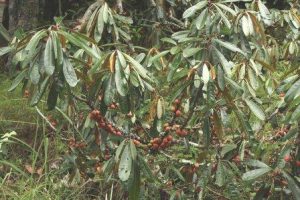
Bequaertiodendron magalismontanum. Photo: Bart Wursten. Source: Flora of Zimbabwe
On the fringes and in close proximity to the forest, the trees in flower were Erythrina abyssinica, Cassia singueana and Dombeya rotundifolia. One of the Dombeyas had a delicate pink tinge to the white flowers. Regeneration within the forest was found to be moderate, with young plants of Bequaertiodendron magalismontanum, Ilex mitis, Celtis africana, Rhamnus prinoides, Rauvolfia caffra and Syzygium cordatum – the latter disappointingly few in view of the number of big water berry trees seemingly reaching climax. Many large bushes of Rhus longipes were in fruit.
In the afternoon a party explored the hills to the North in search of the old homestead known to be somewhere in the vicinity. It found, perhaps a little less than a mile away a towering mass of Mauritius thorn, with a couple of tall flowering Syringas and a large clump of Sisal plants nearby. Somewhere in the middle of the impenetrable thorn (reminiscent of the forest area at its worst in days gone by) there might be the remains or the foundations of an old homestead. It goes without saying that, petrol supplies permitting, and subject to the form owners consent, this discovery will be followed up. The mass could doubtless be burnt, but bitter experience has shown that the seeds thrive on fire.
During the course of our peregrinations there were two people quietly and unobtrusively at work – Mr Stan Carey checking the fencing with members of his staff and arranging a temporary gap in the fence to facilitate our passage through it, and Mrs. Diana Killilea of Henderson Weed Research Unit, treating with arboricide some of the few Mauritius thorn plants which had escaped our last spraying and plucking operations. It was a pleasure to have Mr and Mrs Killilea and their companion, Mr. Dan Gillespie with us for a while.
The outing was presided over by Mr and Mr Coates Palgrave, Meg in her official capacity and both Paul and Meg as hosts and caterers who lavished upon us limitless quantities of tea, coffee, hot water and amiable conversation throughout the day. Their generosity and their concern for everybody’s enjoyment was sincerely appreciated by all.
-R.W.Petheram
Thank you Dick Petheram for that write up about a super day and also for having reclaimed Binga Swamp Forest for us. Many people have played their part in this tremendous achievement but I believe that despite what Dick has said the most effective single contribution towards the elimination and control of Mauritius thorn and other exotics has come from Dick himself. His persistent vigilance, his persuasion for action and his coordination of the responses to his persuasion have resulted in what we can enjoy today.
The other point of interest which Dick has not mentioned was that he had a number of photographs of “before” and “during” which he had taken over the years demonstrating various stages and aspects of the Mauritius thorn problem. These he had mounted on cardboard and cleverly hung by means of curtain hooks (homemade) and bamboo rods on trees around the camp site so that those of us who had not known the forest then were able to see what it had been like. Of course, finding the source of the invader untouched by control measures gave us a wonderfully graphic demonstration of how terrible the Mauritius thorn problem had been in the forest and just how much has been achieved as a result of its elimination. I hope that the destruction of the thorn at the site of the old homestead will be sufficiently delayed for us to be able to arrange for as many people as possible to be shown exactly what Binga Swamp Forest would be like today; and be like tomorrow if control measures were stopped.
-Meg Coates Palgrave
The last week end in August Paul and I were entertained by members of the Ayrshire Branch. What a warm welcome we were given and how we enjoyed botanizing with them. We saw 6 species which had either not been seen before at all or had not previously been seen in their natural habitat. I have prepared a Paddington Bear Scrap Book with the specimens I brought back. Very exciting, there is a blank page where the specimen of Grewia stolzii should be but this has been given to the Herbarium as it is the first record for the ‘North’ area. It could be widespread but just has not been collected from there. We now look to the Ayrshire Branch to send in a steady stream of specimens and so fill in this gap in its distribution.
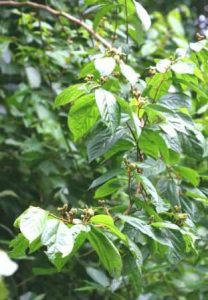
Grewia stolzii. Photo: Bart Wursten. Source: Flora of Zimbabwe
Not only did Mrs. Benedicta (Dickie) Graves accommodate us, feed us and fete us, but she also has written this account of the week end :
On Sunday 30th August 1981 Mfuta Farm, Raffingora, the Ayrshire Branch “meet” for tree hunting was attended by 17 adults and 5 children. In one family three generations were present.
Mr Murray Alexander, our host, made extensive preparations for this visit, renovating roads and clearing overgrowth from the picnic spot on the Hunyani river, some 4.5 miles from the homestead, the Grange, where a welcome and tea awaited us. From the verandah there were glimpses of the middle veld 3,300’ altitude descending to a 3,092’ hot dry countryside except for the treeless expanses of irrigated lands.
Six vehicles led by Mr. Alexander set off to identify trees en route and Paul and Meg Coates Palgrave gave botanical guidance. Strange to relate the first three trees bore the specific name Stuhlmannii; Xeroderris, Lannea and Ficus. As usual Xeroderris with rimmed pods, had prolific galls resembling berries. A tall columnar Euphorbia ingens enmeshed by Ficus stuhlmannii looked ancient and modern and deserved a photograph. The name of the flowering shrub beneath the Lannea was Combretum mossambicensis, a white flowered climbing Combretum.
At the next stop, the party which included some bearded bosses, contemplated the bosses on Acacia nigrescens, the knob thorn, which for various reasons is the easiest Acacia to recognise. Acacia polyacantha, Acacia amythethophylla and Acacia nigrescens are the relics of the valley thorn vegetation left after hundreds of acres were cleared for farm lands.
Large rivers such as the Hunyani have a forest fringe, sometimes called gallery forestry; a picturesque description. The presence of trees does not constitute a forest unless they are close enough together to make a continuous canopy of foliage beneath which is an environment which is darker, moister, cooler and less airy. This vegetation is the haunt of a wide variety of animals; a papery wasp’s next sheltering in a hole in a tree and a monkey passing in the interval between our comings and goings left its little “hand marks” on the path, distinct in the alluvial sandy soil.
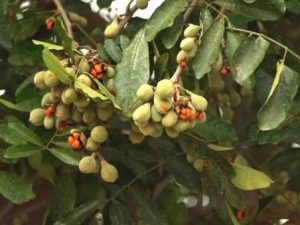
Trichelia emetica. Photo: Bart Wursten. Source: Flora of Zimbabwe
In the old days there were great numbers of mahogany trees along this stretch of the river, many were felled for timber when a steam powered saw mill was installed at the Mill Pool about a mile downstream from where we were but still today the tallest riverine trees are Trichilia emetica, the Natal Mahogany and Khaya nyasica, the Red Mahogany, in company with Kigelia africana, Celtis africana and Albizia versicolor. The abundant water supply allows the deciduous species to lose their leaves only for a short time, e.g. Diospyros mespiliformis is practically evergreen. Its common name is Jackal berry which is probably the Afrikaans way of saying that the fruit is “useless” only worthy of a jackal and not delicious like Diospyros kirkii, sometimes called the Wild Persimmon, which it resembles. So the chance of shooting rabid jackals beneath the fruiting branches of this tree is very remote.
An under storey of smaller trees and shrubs mounted the steep bank and amongst them was a large African Blackwood, Dalbergia melanoxylon, recently cut down and taken away, Dombeya kirkii, river Dombeya, Psorospermum febrifugum, Christmas berry, Feretia aeruginescens (with bronze colours on its winter leaves, aeruginous means like copper rust) and Terminalia sericea growing in the sand deposited by the river in flood. In the time of ancient iron workers, the wood favoured for charcoal was Terminalia sericea which had the virtue of increasing the iron yield from the ore. The high alkali content of the wood is the chemical reason for this.
Grewia flavescens also has some historic associations; its square stems have been found imprinted in lumps of hut daga on old living sites on kopjes where tribesmen took refuge during migrations of the first Zimbabwe peoples into Northern Mashonaland and again when the Mashonas were harassed by the Matabele.
Shade tolerant Stemfruit, Englerophytum magalismontanum, attracted attention because of its tiny crimson flowers (to be followed by edible red berries which pop out of its trunk and encircle the branches. Frugivorous animals feed on the “miniature Vienna sausages” borne in clusters on Friesodielsia obovata at most seasons of the year; Homo sapiens could find only one dried up old fruit. The Monkey Bread Trees, spicy smelling pod was sampled, happily its name has returned to Bauhinia thonningii.
Arching fronds of the wild date palm, Phoenix reclinata, added character to the scenery and the Riverine Sandpaper fig, Ficus capreifolia, grew at the water’s edge true to its genus its leaves dried and became shattered minutes after being packed.
After hours of intensive study everyone was content to collapse in the shade, have lunch and listen to the sounds of the river and the birds, a peaceful scene. Across the Hunyani an eagle attended its nest; and a little Bee–eater, an Emerald Spotted Wood Dove and a Brown hooded Kingfisher, more Lowveld species, were at home in this middle altitude. More typical of the Highveld, the Grey headed Bush Shrike (described by Jeff Huntly as the “ultimate” in shrikes) was observed and Heuglin’s Robin was heard.
Finally tea and refreshment at the Grange. Very many thanks to Murray and Carol Alexander for their hospitality and for spending the whole day with members and guests of the Ayrshire Branch.
Coates Palgraves and Graves bade farewell to the riverside lunch scene and set off to Gomo Estate where Mr. Ian Barron greeted them at his boundary gate just after 1500 hours. Walking in the dry deciduous woodlands our host drew attention to recently cut trees, sad to see on this hitherto unspoilt farm. Mr. Barron is dedicated to preserving natural woodland and has been growing gum trees for the last 20 years for use on the farm. Aware that his employees do not like the wood for their fires, he gave them some Cedrela, Toona ciliata, which they preferred.
We found a Mimusops zeyheri, is dark green crown overhanging granite so that its seeds were easily collected and pustules were seen on Julbernardia globiflora, mnondo, which recalled the visit to Spelonken where their aetiology was explains and forgotten …… a ‘recap’ please.
The gracious welcome and delicious tea served us by Mrs Barron and her family in the garden in the shade of a large Trichilia, self seeded with living memory, was appreciated.
Finally we were shown several kinds of trees (including Tickey Tree, Diospyros natalensis, better known as Diospyros nummularia) which had been rescued during the stumping and clearing of the bush many years ago and which now graced the homestead. Surprisingly shapely “instant trees” grown from truncheons, were Commiphora africana, a fig and an Erythrina which grew beside another self seeded Natal Mahogany, Trichelia emetica, among the farm out buildings.
The 30th August 1981 will be remembers as Mahogany Day by the Ayrshire Branch of the Tree Society of Zimbabwe.
Thank you Dickie for that account of a wonderful day. I hope to be able to include a re-cap of the “pustules” of Julbernardia in the January Newsletter.
-Benedicta (Dickie) Graves
MATABELELAND CALENDAR
4th October : To Matopos, the rendezvous is at Retreat Shopping Centre at 0830 hours.
1st November : To Criterion area, the site of old Bulawayo, going out on the Hope Fountain Road. Meet at 53 Napier Avenue by kind permission of Andrew Jarvis to arrange seating at 0830 hours.
This year the spring tints spectacular has been country wide and from Bulawayo we have this note from Miss Janet Webber
The September field meeting was something to be remembered always for the Msasa foliage was at its spring best with delicate shades of colour. Whilst it was sunny enough to see it in all its glory, it was cool for climbing kopjes and we had a fine view of the Mtsheleli Dam in the distance. So cool was it that we did not see the insect seeking bird parties we expected. Another surprise which awaited us on the kopje was finding the dominant trees – Teclea and Vepris spp.
-J.Webber
SUBSCRIPTIONS
The Committee has reluctantly decided that next year subscriptions will have to be increased by $1. Single Membership $4 and Family Membership $5 and this is to give you three months notice of our intention as required by the Constitution. In these times of rising prices Treasurer Ian Milton is quite frankly unable to predict expenditure but says that while we may not run at a loss we may do so and I am sure you will all agree that under no circumstances should this be allowed to happen.
-Meg Coates Palgrave Chairperson


